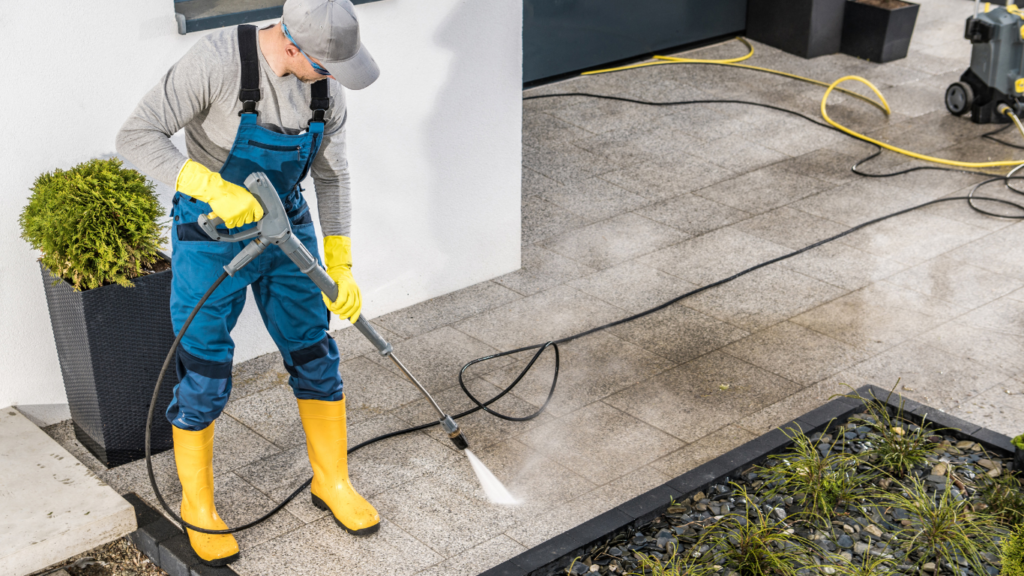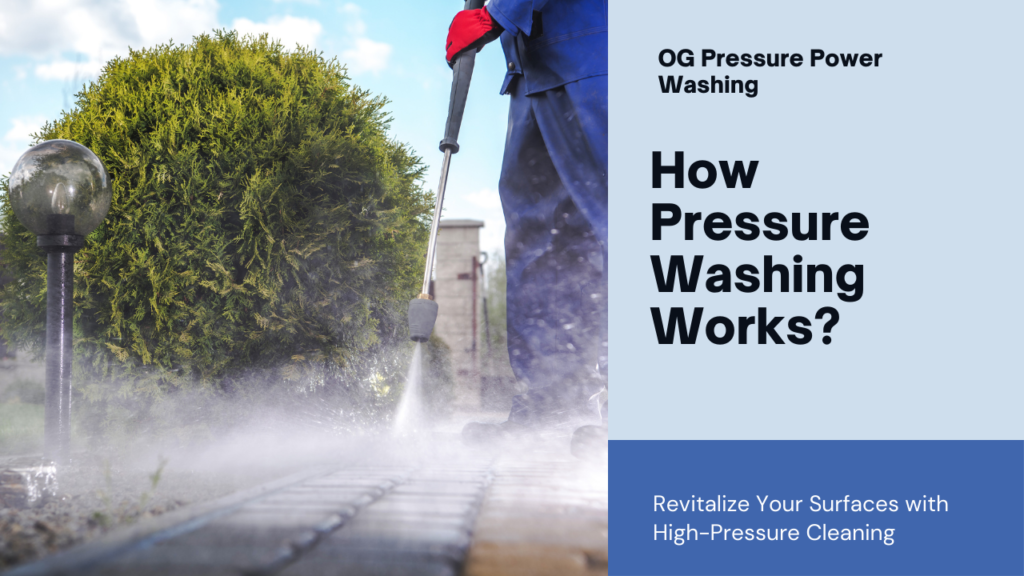Pressure washing is a highly effective method for cleaning a wide range of surfaces, from residential driveways to commercial buildings. Understanding how pressure washing works can help you make the most of this powerful cleaning technique, whether you’re a homeowner looking to spruce up your property or a business owner aiming to maintain a professional appearance.
This article provides a comprehensive look at the science behind pressure washing, the equipment involved, techniques for different applications, and important safety and environmental considerations. By the end, you’ll have a thorough understanding of how pressure washing works and how it can benefit you.
Pressure Washing
To grasp how pressure washing works, it’s essential first to define what it is. Pressure washing involves using a high-pressure water spray to remove dirt, grime, mold, mildew, and other contaminants from surfaces. It’s different from power washing, which also uses heated water, making it more effective for certain applications.
Pressure washing is versatile and can be used in various settings. Residential applications include cleaning home exteriors, driveways, and patios. Commercially, pressure washing is used on building exteriors, sidewalks, and parking lots. Industrial settings use it for heavy equipment, warehouses, and manufacturing facilities.
The Science Behind Pressure Washing
Understanding the science behind how pressure washing works involves knowing the basic principles and components of a pressure washer. The primary factors are water pressure, measured in pounds per square inch (PSI), and flow rate, measured in gallons per minute (GPM). Together, these determine the cleaning power of a pressure washer.
Key components of a pressure washer include:
| Water Pump | The heart of the pressure washer, is responsible for generating high pressure. |
| Engine or Motor | Powers the water pump, with electric motors for residential units and gas engines for more powerful, commercial-grade machines. |
| High-Pressure Hose | Transports water from the pump to the spray gun. |
| Nozzles and Spray Tips | Attachments that control the spray pattern and pressure, crucial for different cleaning tasks. |
Pressure washers work by drawing water from a source and then pressurizing it through the pump. The pressurized water is then expelled through a high-pressure hose and nozzle, allowing it to effectively clean surfaces by blasting away dirt and debris.
Types of Pressure Washers
Understanding the different types of pressure washers is key to knowing how pressure washing works. They can be categorized by their power source, water temperature, and mobility.
Electric vs. Gas-Powered Pressure Washers
Electric pressure washers are generally quieter, lighter, and more suitable for small to medium tasks. They require less maintenance and are easier to start. Gas-powered pressure washers, on the other hand, offer more power and mobility, making them ideal for heavy-duty tasks but require more maintenance and are noisier.
Cold Water vs. Hot Water Pressure Washers
Cold water pressure washers are adequate for most cleaning tasks and are less expensive. However, hot water pressure washers are more effective at removing grease and oil, as the heated water breaks down these substances more efficiently.
Portable vs. Stationary Pressure Washers
Portable units are versatile and can be used in various locations, making them ideal for residential and small commercial tasks. Stationary pressure washers are fixed in one place and are typically used in industrial settings where high-volume, frequent cleaning is necessary.
Pressure Washing Techniques
The effectiveness of pressure washing depends not just on understanding how pressure washing works but also on using the correct techniques and equipment.
Choosing the Right Nozzle
Different nozzles provide different spray patterns and pressures. Common types include:
- 0-Degree Nozzle: Produces a pinpoint jet of water for tough stains.
- 15-Degree Nozzle: Creates a narrow fan spray for surface preparation.
- 25-Degree Nozzle: A wider fan spray suitable for general cleaning.
- 40-Degree Nozzle: A wide fan spray for gentle cleaning.
- Soap Nozzle: Used for applying detergent.
Preparing the Area and Surface
Before pressure washing, clear the area of debris and furniture. Pre-treat any stains with appropriate cleaners and ensure all windows and doors are closed to prevent water ingress.
Proper Pressure Washing Methods
| Concrete | Use a higher pressure and a 25-degree nozzle. Keep the nozzle moving to avoid etching the surface. |
| Wood | Use a lower pressure and a 40-degree nozzle to prevent damage. Always follow the grain of the wood. |
| Siding | Use a medium pressure and a 25- or 40-degree nozzle. Avoid spraying water upwards into seams to prevent water from getting behind the siding. |
Environmental Considerations
Understanding how pressure washing works also involves recognizing its environmental impact.
| Water Usage and Conservation | Pressure washing can use a significant amount of water. To conserve, use a pressure washer with adjustable flow rates and only wash areas that truly need it. |
| Managing Runoff and Contaminants | Prevent contaminated runoff from entering storm drains by using containment systems and eco-friendly detergents. |
| Eco-Friendly Detergents and Cleaning Solutions | Choose biodegradable and non-toxic cleaning agents to minimize environmental harm. |
Maintenance and Care of Pressure Washers
Proper maintenance is crucial to ensure your pressure washer continues to work effectively.
You must regularly check and clean filters and nozzles to prevent clogs. Then, look for leaks and wear to avoid malfunctions. Also, it is important that you store your pressure washer in a dry, sheltered place to protect it from the elements.
Unlocking the Power of Pressure Washing

Pressure washing is a powerful tool for maintaining cleanliness and enhancing the appearance of various surfaces. Understanding how pressure washing works, from the science behind it to the equipment and techniques involved, can help you achieve the best results. Whether you choose to hire a professional or tackle the job yourself, the benefits of pressure washing are clear. It can save you time, improve your property’s curb appeal, and protect surfaces from damage over time.

